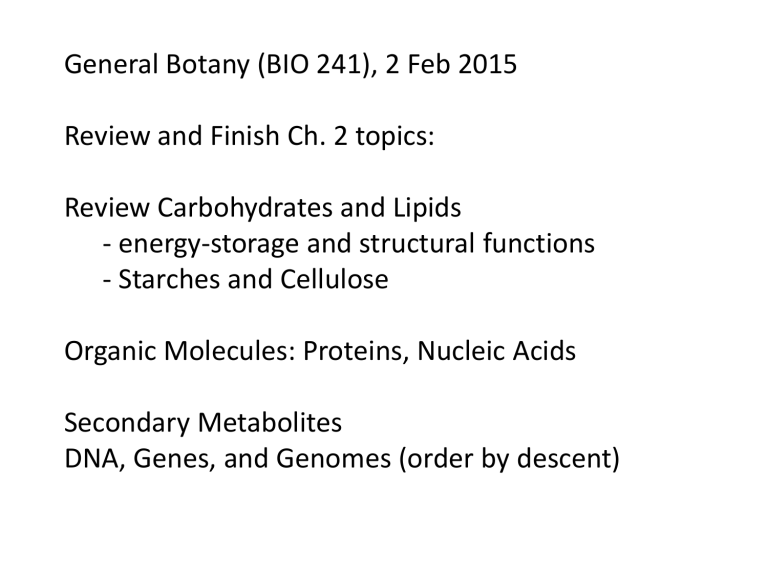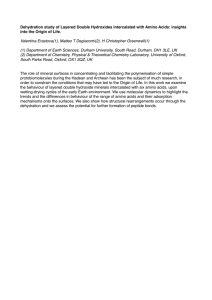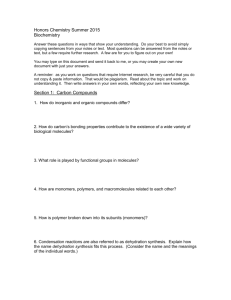General Botany (BIO 241), 2 Feb 2015 Review Carbohydrates and Lipids

General Botany (BIO 241), 2 Feb 2015
Review and Finish Ch. 2 topics:
Review Carbohydrates and Lipids
- energy-storage and structural functions
- Starches and Cellulose
Organic Molecules: Proteins, Nucleic Acids
Secondary Metabolites
DNA, Genes, and Genomes (order by descent)
Carbohydrates
• Monomers = simple sugars, monosaccharides
- C, H, and O in 1:2:1 ratio (eg. C
6
H
12
O
6
)
- (CH
2
O) n
, n= 3-7 (5, 6 most common)
- C-skeleton with
-OH (hydroxyl) groups
1 –C=O (carbonyl) group
Hydrophilic or Hydrophobic?
Yes: Hydrophilic
Monosaccharides
Chain and Ring forms
- In solution, monosaccharides exist mainly in ring form (99%)
- Carbonyl group hydroxyl
- Equilibrium of 2 isomers, A and B, depending on orientation of OH relative to C6
Disaccharides
• Dehydration synthesis reaction between monosaccharides. )
- requires E input of 5.5. kcal/mole)
• Sucrose is the primary form in
Which sugars are transported in plants
(phloem sap).
Polysaccharides: polymers of monosaccharides
• Formed by dehydration synthesis reactions (occurs in amyloplasts)
• Energy Storage – must be hydrolyzed before being transported or used as energy source (input to respiration)
Plants:
-Starches - Alpha glucose subunits
Amylose - unbranched
Amylopectin - branched
-Fructans (wheat, rye, barley) – fructose subunits
Animals, fungi, prokaryotes:
- glycogen (alpha glucose subunits)
Structural Polysaccharide – Cellulose (Beta-glucose subunits)
Triglycerides: glycerol with fatty acid sidechains
Fats and oils: triglycerides that store energy
Phospholipids: structural lipids
Self-assemble as a bilayer membrane in “solution”
Lipids: steroids and sterols
Chemical characteristics: 4 interconnected hydrocarbon rings (= steroid) sterols = steroids with hydroxyl group on C-3 various side-chains (hydrocarbons, hydroxyls, hydroxyl groups)
Functions:
Structural (part of membranes)
Hormones (signaling molecules)
Proteins
Amino acid (protein subunit)
- amino group (NH
2
)
- carboxyl group (COOH)
- R-group (variable)
Peptide bond = Linkage N of amino group and C of carboxyl group by Dehydration Rxn.
Primary structure: sequence of amino acids. Directly encoded in DNA
Protein Secondary Structure: interactions among amino acids
- hydrogen bonding
- R-groups point outward (in helix) or
Up/Down (pleated sheet), giving the protein its solubility and reactivity characteristics.
Alpha Helix
Amino acid R-groups and protein placement
R-group polarity in regions of protein 2° structure determines placement of peripheral and transmembrane proteins.
Hydrophobic Amino Acids
Fluid Mosaic Model
Nucleic Acids
-composed of nucleotides
Nucleotide parts:
- nitrogenous base adenine cytosine guanine thymine uracil
- sugar ribose (5-C) deoxyribose (6-C)
- phosphate
DNA= deoxyribose, ACTG
RNA= ribose, ACUG
DNA: Double stranded; each strand is the reverse complement of the other .
Hydrogen bonding between nucleotide pairs: A ------ T/U C ------G
Nucleotides are linked into amino acids by dehydration synthesis.
ATP – adenosine (a nucleotide) triphosphate
Function: Cellular Energy Currency



